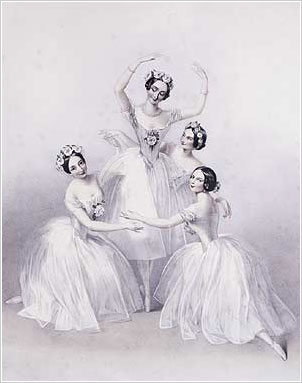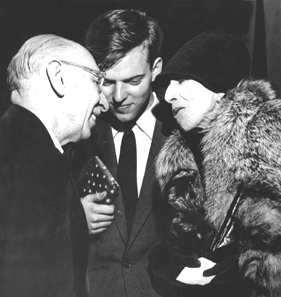Related Research Articles

George Balanchine was an ethnic Georgian-American ballet choreographer who was one of the most influential 20th-century choreographers. Styled as the father of American ballet, he co-founded the New York City Ballet and remained its artistic director for more than 35 years. His choreography is characterized by plotless ballets with minimal costume and décor, performed to classical and neoclassical music.

A branle, also bransle, brangle, brawl, brawle, brall(e), braul(e), brando, bran, or brantle, is a type of French dance popular from the early 16th century to the present, danced by couples in either a line or a circle. The term also refers to the music and the characteristic step of the dance.

Pas de quatre is a French term used to identify a ballet dance for four people. Pas de quatre are usually plotless dances performed as divertissements within the context of a larger work. However, narrative pas de quatre and pas de quatre that stand alone are not unknown.
Elegy for J.F.K. is a piece of vocal music composed by the Russian-born composer Igor Stravinsky in 1964, commemorating the assassination of U.S. President John F. Kennedy.

Apollo is a neoclassical ballet in two tableaux composed between 1927 and 1928 by Igor Stravinsky. It was choreographed in 1928 by twenty-four-year-old George Balanchine, with the composer contributing the libretto. The scenery and costumes were designed by André Bauchant, with new costumes by Coco Chanel in 1929. The scenery was executed by Alexander Shervashidze, with costumes under the direction of Mme. A. Youkine. The American patron of the arts Elizabeth Sprague Coolidge had commissioned the ballet in 1927 for a festival of contemporary music to be held the following year at the Library of Congress in Washington, D.C.

Tchaikovsky Pas de Deux is a ballet choreographed by George Balanchine to a composition by Pyotr Ilyich Tchaikovsky originally intended for act 3 of Swan Lake. With costumes by Barbara Karinska and lighting by Jack Owen Brown, it was first presented by New York City Ballet at the City Center of Music and Drama, New York, on 29 March 1960. Robert Irving conducted the New York City Ballet Orchestra. The dancers were Violette Verdy and Conrad Ludlow.
Requiem Canticles is a 15-minute composition by Igor Stravinsky, for contralto and bass soli, chorus, and orchestra. Stravinsky completed the work in 1966, and it received its first performance that same year.
Orpheus is a thirty-minute neoclassical ballet in three tableaux composed by Igor Stravinsky in collaboration with choreographer George Balanchine in Hollywood, California in 1947. The work was commissioned by the Ballet Society, which Balanchine founded together with Lincoln Kirstein and of which he was Artistic Director. Sets and costumes were created by Isamu Noguchi.
Maryon Lane was a South African ballet dancer who became well known in Britain as a ballerina of the Sadler's Wells Theatre Ballet and as a soloist with the Royal Ballet.

William Dollar was an American dancer, ballet master, choreographer, and teacher. As one of the first American danseurs nobles, he performed with numerous companies, including the Philadelphia Opera Ballet, the American Ballet, Ballet Caravan, Ballet Society, Ballet Theatre, and New York City Ballet.

Ekaterina Valerievna Krysanova is a Russian principal dancer of Bolshoi Ballet.
"Epitaphium" is a short chamber-music composition by Igor Stravinsky, for flute, clarinet, and harp. The score was composed in 1959 and is inscribed in German, "Für das Grabmal des Prinzen Max Egon zu Fürstenberg". A performance last for less than two minutes.

The Double Canon is a short composition for string quartet by Igor Stravinsky, composed in 1959. It lasts only about a minute and a quarter in performance.
Danses concertantes is the title of a work for chamber orchestra written in 1941–42 by Igor Stravinsky, commissioned by Werner Janssen. Stravinsky's music has been used for eponymous ballets by numerous choreographers attracted by its danceability.
Danses concertantes is a work for chamber orchestra by Igor Stravinsky, composed in 1942. A performance lasts about twenty minutes. Although written as an abstract ballet for concert performance, it has been choreographed numerous times.

Giuseppe Anneda was an Italian mandolin virtuoso who helped the mandolin gain more importance in the classical music world in the 20th Century. He performed with his instrument in concert halls around the world, including some where mandolin "had never entered", and taught at the Conservatory Pollini of Padua He also was able to gain access to manuscripts in museums, rediscovering works by Vivaldi, Pergolesi, Beethoven and many others.
Duo Concertant is a ballet choreographed by George Balanchine to Stravinsky's score of the same name. The ballet was created for New York City Ballet's Stravinsky Festival, a tribute to the composer a year after his death, and premiered on June 22, 1972, at the New York State Theater, danced by Kay Mazzo and Peter Martins.
References
- ↑ Walsh, Stephen (2006). Stravinsky: The Second Exile (France and America, 1934–1971). New York City: Alfred A. Knopf. p. 365. ISBN 0-375-40752-9.
- ↑ White 1979, p. 490.
- ↑ White 1979, pp. 490–1.
- ↑ Smyth 1999, pp. 121, 126–7.
- ↑ Straus, Joseph N. (2001). Stravinsky's Late Music. Cambridge Studies in Music Theory and Analysis. Cambridge and New York City: Cambridge University Press. pp. 143–5. ISBN 0-521-60288-2.
- ↑ Smyth 1999, p. 133.
- ↑ "Giuseppe Anedda: Cagliari 1/3/1912 – Cagliari 30/7/1997". Amromana.it. Archived from the original on September 28, 2015. Retrieved September 27, 2015.
- ↑ Morbelli, Riccardo (April 5, 1965). "Stravinski: «Bravo mandolino»". Stampa Sera . Vol. 97, no. 80. p. 9.
Sources
- Smyth, David (Summer 1999). "Stravinsky's Second Crisis: Reading the Early Serial Sketches". Perspectives of New Music . 37 (2): 117–146. doi:10.2307/833512. JSTOR 833512.
- White, Eric Walter (1979). Stravinsky: The Composer and His Works (2nd ed.). Berkeley and Los Angeles: University of California Press. ISBN 0-520-03985-8.